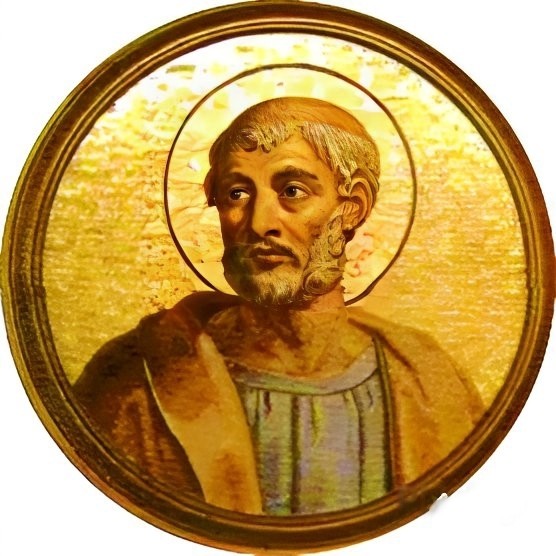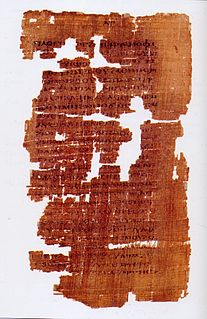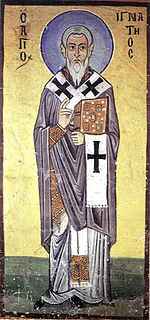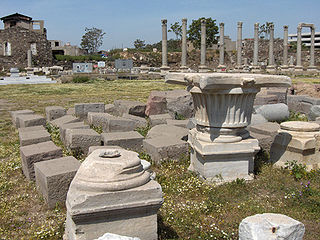
The Epistle of Paul to the Philippians, often referred to simply as Philippians, is the eleventh book in the New Testament. Paul and Silas first visited Philippi in Greece during Paul's second missionary journey, which occurred between approximately 49 and 51 AD. Philippi was the location of the first Christian community established in Europe.

Pope Clement I, also known as Saint Clement of Rome, is listed by Irenaeus and Tertullian as Bishop of Rome, holding office from 88 to his death in 99. He is considered to be the first Apostolic Father of the Church, one of the three chief ones together with Polycarp and Ignatius of Antioch.

Saint Onesimus, also called Onesimus of Byzantium and The Holy Apostle Onesimus in some Eastern Orthodox churches, was probably a slave to Philemon of Colossae, a man of Christian faith. He may also be the same Onesimus named by Ignatius of Antioch as bishop in Ephesus which would put Onesimus's death closer to 95 A.D. Regardless, Onesimus went from slave to brother to Bishop.

An epistle is a writing directed or sent to a person or group of people, usually an elegant and formal didactic letter. The epistle genre of letter-writing was common in ancient Egypt as part of the scribal-school writing curriculum. The letters in the New Testament from Apostles to Christians are usually referred to as epistles. Those traditionally attributed to Paul are known as Pauline epistles and the others as catholic epistles.

The Syriac Orthodox Church of Antioch, or Syriac Orthodox Patriarchate of Antioch and All the East, is an Oriental Orthodox Church with autocephalous patriarchate established by Severus of Antioch in Antioch in 518, tracing its founding to Antioch by Saint Peter and Saint Paul in the 1st century, according to its tradition. The Church uses the Divine Liturgy of Saint James, associated with St. James, the "brother" of Jesus and patriarch among the Jewish Christians at Jerusalem. Syriac is the official and liturgical language of the Church based on Syriac Christianity. The primate of the church is the Syriac Orthodox Patriarch of Antioch currently Ignatius Aphrem II since 2014, seated in Cathedral of Saint George, Bab Tuma, Damascus, Syria.

The Syriac Catholic Church, also known as Syriac Catholic Patriarchate of Antioch, is an Eastern Catholic Christian Church in the Levant that uses the West Syriac Rite liturgy and has many practices and rites in common with the Syriac Orthodox Church. Being one of the twenty-three Eastern Catholic Churches, the Syriac Catholic Church has full autonomy and is a self-governed sui iuris Church while it is in full communion with the Holy See of Rome.
Patriarch of Antioch is a traditional title held by the Bishop of Antioch As the traditional "overseer" of the first gentile Christian community, the position has been of prime importance in the church from its earliest period. This diocese is one of the few for which the names of its bishops from the apostolic beginnings have been preserved. Today five churches use the title of Patriarch of Antioch: the Syriac Orthodox Church, the Greek Orthodox Church of Antioch, the Syriac Catholic Church, the Melkite Greek Catholic Church, and the Maronite Church. Historically, there has also been a Latin Patriarch of Antioch.
The Apostolic Fathers were Christian theologians who lived in the 1st and 2nd centuries AD, who are believed to have personally known some of the Twelve Apostles, or to have been significantly influenced by them. Their writings, though popular in Early Christianity, were not included in the canon of the New Testament. Many of the writings derive from the same time period and geographical location as other works of early Christian literature which came to be part of the New Testament. Some of the writings found among the Apostolic Fathers appear to have been highly regarded as some of the writings which became the New Testament.
The Lost Books of the Bible and the Forgotten Books of Eden (1926) is a collection of 17th-century and 18th-century English translations of some Old Testament Pseudepigrapha and New Testament Apocrypha, some of which were assembled in the 1820s, and then republished with the current title in 1926.
The Letter to the Smyrnaeans was written by Saint Ignatius of Antioch around AD 107 to the Early Christians in Smyrna.

The First Epistle of Clement is a letter addressed to the Christians in the city of Corinth. The letter was composed at some time between AD 70 and AD 140, most likely around 96. It ranks with Didache as one of the earliest—if not the earliest—of extant Christian documents outside the canonical New Testament. As the name suggests, a Second Epistle of Clement is known, but this is a later work by a different author. Neither 1 nor 2 Clement are part of the canonical New Testament, but they are part of the Apostolic Fathers collection.

Christianity in the 2nd century was largely the time of the development of variant Christian teachings, and the Apostolic Fathers who are regarded as defenders of the developing proto-orthodoxy. Major figures who were later declared by the developing proto-orthodoxy to be heretics were Marcion, Valentinius, and Montanus.
The Liturgy of the eighth book of the Apostolic Constitutions is a complete text of the Christian Divine Liturgy and found in the eighth book of the Apostolic Constitutions. It is the oldest known form that can be described as a complete liturgy and can be dated to the second half of the 4th century. It belongs to the Antiochene Rite.

Saint Peter, also known as Simon Peter, Simeon, Simon, or Cephas, according to the New Testament, was one of the Twelve Apostles of Jesus Christ, leaders of the early Christian Great Church. Pope Gregory I called him repeatedly the "Prince of the Apostles". According to Catholic teaching, Jesus promised Peter in the "Rock of My Church" dialogue in Matthew 16:18 a special position in the Church. He is traditionally counted as the first Bishop of Rome—or pope—and also by Eastern Christian tradition as the first Patriarch of Antioch. The ancient Christian churches all venerate Peter as a major saint and as the founder of the Church of Antioch and the Roman Church, but differ in their attitudes regarding the authority of his present-day successors.

The Church Fathers, Early Church Fathers, Christian Fathers, or Fathers of the Church were ancient and influential Christian theologians and writers. There is no definitive list. The era of these scholars who set the theological and scholarly foundations of Christianity largely ended by AD 700.
The Letter to the Romans by Ignatius, an early-second-century Bishop of Antioch, was written during his transport from Antioch, Syria, to his execution in Rome. One of seven extant epistles written by Ignatius, Romans is Ignatius’ most detailed explanation of his views on martyrdom.

The Letter to the Magnesians is an early-second-century letter by Ignatius, Bishop of Antioch Church Father and martyr, was written to the church in Magnesian during the bishop's transport from Antioch, Syria, to his execution in Rome. Magnesians is one of seven epistles written by Ignatius to early centers of Christianity in Anatolia.
















